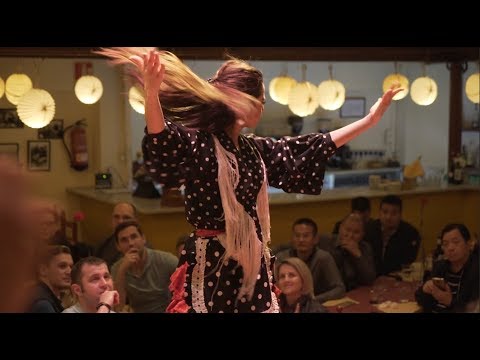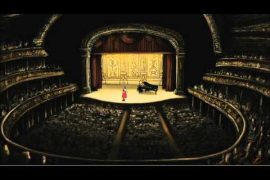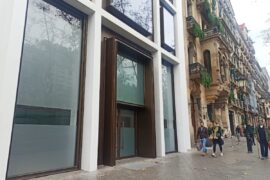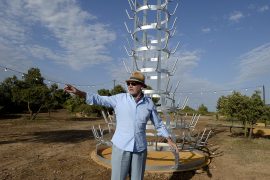[dropcap letter=”T”]
he story behind Tablao de Carmen is not just any story. It is a thrilling adventure that took its first steps much before its actual existence with intertwining characters and significant moments for the flamenco world. Let us hope one day someone will gather the courage to explain it with love and accuracy, and at length, beyond this short article’s length.
It all began in 1929, when a young teenage Carmen Amaya danced before the Spanish King Alphonse XIII in the opening ceremony of the Universal Exposition held in Pueblo Español in Barcelona
In 1988, amidst the Barcelona pre-Olympics, Tablao de Carmen opened its doors. Barcelona displayed an unprecedented commitment and energy to live up to the lofty endeavour of this huge event and surrendered to the charms of design, city planning, technological future, the Torres de Ávila centre and Mariscal. But flamenco music was out of fashion. Despite this, Sunchy Echegaray, the soul and founder of Carmen’s patio, took the project forward, despite time not being on her side. Sunchy Echegaray, the soul and founder of the project, took it over despite being poorly gifted to become a businessperson. Against all odds, she decided to take the project forward and embark on this business, as she felt incapable of turning down the project that had just landed in her hands. Too many things coincided in Calle de los Arcos, a small replica of a Cordobese patio. The story had started being written much before then and the emotional bonds were already too strong.
It all began in 1929, when a young teenage Carme Amaya danced before the Spanish King Alphonse XIII in the opening ceremony of the Universal Exposition held in Pueblo Español in Barcelona –an enclosed open-air location created for this occasion–. After the event, the whole Amaya troupe settled down in a Cordobese patio, called back then El Patio del Farolillo, and performed there for a whole year. As the 20th century passed by and Barcelona was quickly becoming a flamenco festival. By then, the flamenco art was very much in fashion. For several reasons, but mainly because of its status as a welcoming city of migrant population, especially from the south of Spain, the city was turning into the main flamenco city in Spain. Such phenomenon is narrated in the extraordinary thesis written by Montse Madridejos (El flamenco en la Barcelona de la exposición internacional 1929-1930. Edicions Bellaterra, 2012).
Carmen and Sunchy met each other in Begur and soon became good friends. Then Carmen died and much later, Sunchy married her widower, Juan Antonio Agüero, and had two daughters with him
Decades later, the connections strengthened. Sunchy landed on Carmen Amaya’s lap, in a successful return back from the United States. Sunchy, who had just turned eight and had seen the show as an spectator –and later saw her backstage–, accompanied by the renowned flamenco dancer Concha Borrull –family friend and personal dance teacher–, gave Amaya her brand new autograph book –incidentally, she was so young that she hardly knew what an autograph was– for “la Capitana” to sign. This is how the most famous gypsy in the Catalan Somorrostro began a book, nowadays almost completed with signatures from flamenco dancers and singers, a true testimony of its owner’s passion for this artistic discipline.
Twenty years on, the story rushed forward. Carmen and Sunchy met each other in Begur and soon became good friends. Then Carmen died and much later, Sunchy married her widower, Juan Antonio Agüero, and had two daughters with him.
Then, when everything in life looked to move into another direction, which threatened to leave this whole story behind, where only memories remained, Sunchy received a phone call with a project that would turn the whole thing around. As she walked into the Cordobese patio in Pueblo Español of Patio del Farolillo –popularly renamed as Patio de Carmen– she could not have no for an answer. There are many reasons for this acceptance. She had been brooding for some time over the idea of setting up a small flamenco-style tavern. How could she reject opening up one here? And all the lives, hers and the ones of those who she loved, all this passion for flamenco, were hatched there.
In a small tavern. In a tavern that breaks away from closed choreographies, that looks for authenticity in an art bred in the streets, in homes, in gypsy weddings. One of the main targets of this flamenco joint is to preserve the essence of spontaneous, improvised dance, with children and teenagers starting dancing and singing during the weekends. This is why Sunchy and Mimo Agüero, her daughter and business manager since 2015, are tightly linked to so many gypsy families, cousins, nephews and nieces from the districts of San Roque, Badalona, La Mina, distant relatives of Carmen’s, which is where the most authentic flamenco originates, with families attending every evening to see the show of their talented members.
Already thirty years after the creation of a flamenco tablao. But you will agree with me that this is more than that. It is a small portion of the history of our city, of the many Barcelonas in Barcelona, which has not been explained as it deserves.





















